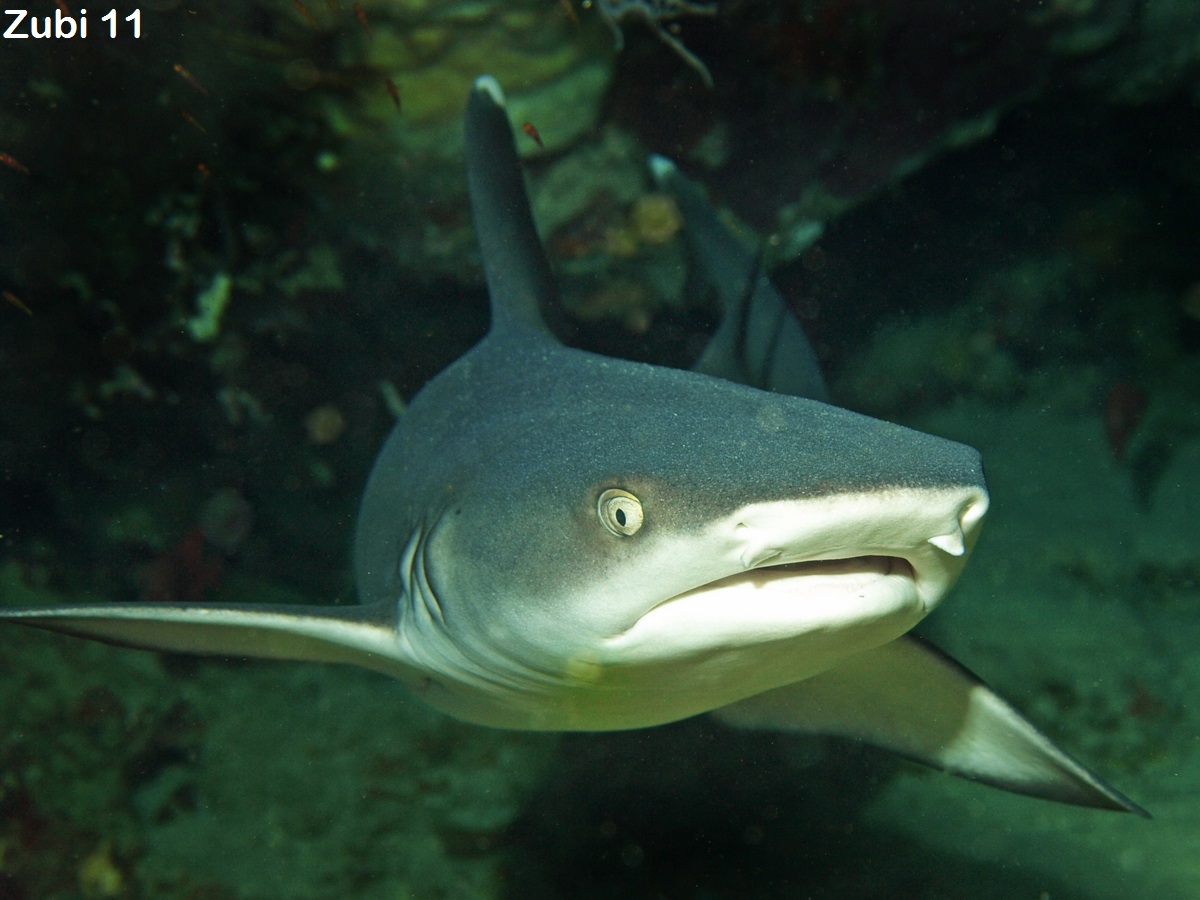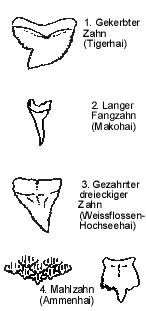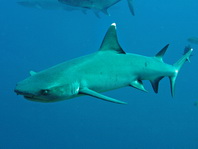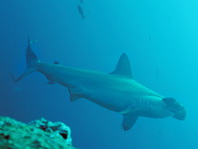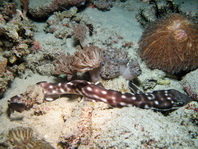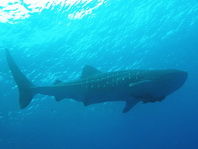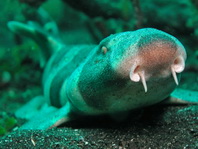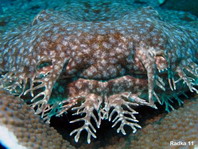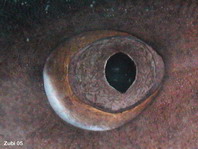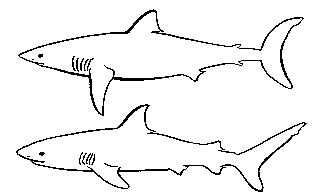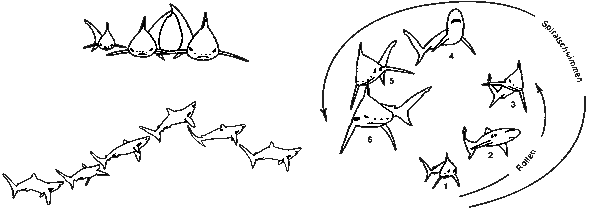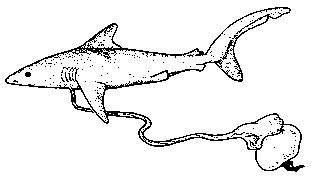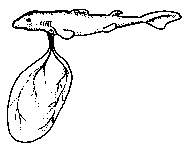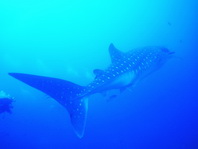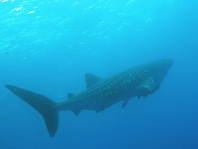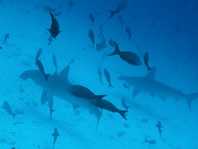|
|
||||||||||||||
| Diese Seite auf Deutsch |
Multi-celled animals (Metazoa) |
|||||||||||||
CARTILAGINOUS FISHES |
CHORDATA (VERTEBRATES)Sharks (Selachii)
Photos of sharks Characteristics - Ecology and range - Behavior (locomotion - feeding - respiration - senses - predatory behavior - reproduction) - shark families - danger to sharks Shark families: whale shark - zebra shark - nurse shark - wobbegong - bamboo shark - cat shark - requiem shark (reef sharks,oceanic sharks etc.) - hammerhead shark Over 1000 photos of fishes (one page each about Sharks and Rays) - Index of all Fish photos - Index only photos of Sharks |
|||||||||||||
|
|
||||||||||||||
Sharks(Selachii) |
Sharks, rays, skates and chimaeras belong to the cartilaginous fishes (Chondrichthyes) as opposed to the bony fishes (Actinopterygii, formerly Osteichthyes). Sharks are divided into 21 families and approx. 350 species. Sharks represent an extremely ancient lineage. The basic physiology of sharks has changed very little over the past 450 million years (Silurian Period) since they appeared on the evolutionary scale. |
|||||||||||||
|
|
||||||||||||||
|
placoid scales / denticles
|
CharacteristicsSharks have a skeleton composed of cartilage rather than bone. Only their jaws are calcified. Cartilage is an ideal tissue for the shark skeleton because it is lighter than bone, which is important for sharks do not have a swim bladder. Chondrichthyes differ from the majority of fish species in that, instead of having scales, their skin is protected by primitive placoid structures called denticles or placoid scales. The pointed end of these denticles projects toward the tail. These modified scales may overlap or may be widely spaced. With their serrated edges they give the shark skin its abrasive texture. Many species of sharks have formidable slanting teeth. Typically they have an outer row of well developed upright teeth and several inner rows of teeth in various stages of development which are folded downward. Teeth are continuously produced throughout the life (the tigershark uses up to 140 teeth per year) and each row moves forward to replace the next row every few weeks. The degree of specialization in feeding is indicated by the shape and size of a shark's teeth. The notched teeth with a serrated edge of the tiger shark (1.) or thin, dagger-like teeth, as in the shortfin mako shark (2.) are for grabbing and holding prey. Serrated, wedge-shaped teeth for cutting out big mouthfuls are found in the oceanic whitetip shark (3.). Small conical teeth help the nurse shark (4.) crush prey such as crabs and mollusks. Sharks can be identified by their teeth. |
|||||||||||||
|
|
||||||||||||||
Photos of sharks (photo collection) click for enlargement
|
||||||||||||||
|
|
||||||||||||||
|
|
Ecology and rangeSharks life in saltwater as well as in fresh water (Ganges). They inhabit oceanic waters (pelagic) but also dwell on the bottom (benthic) in caves and under rock ledges. The great majority live in temperate and tropical regions. Some occur in cold water and in a variety of depths ranging from shallow intertidal pools to deep oceanic trenches. |
|||||||||||||
|
|
||||||||||||||
| top |
BehaviorLOCOMOTIONSharks are known for their speed and maneuverability in the water. Most species can swim at speeds of 30 to 50 kilometer per hour. The speed of the mako when attacking has been recorded at more than 90 kilometer per hour! With a few exceptions, sharks have torpedo-shaped bodies, an efficient, streamlined design for fast-swimming predators. Bottom dwellers such as the bambooshark tend to be stout and heavy bodied. Oceanic sharks differ in the form of their caudal fin or tail from bottom dwelling sharks. The form of the tail gives a clue about their swimming abilities. The oceanic whitetip has a moon-shaped tail and also oversized pectoral fins and is a strong swimmer. The whitetip reef shark has a asymmetric tail, with the upper lobe being longer than the lower and inhabits coral reefs where he frequently rests on the bottom in caves or in the open.
|
|||||||||||||
|
|
||||||||||||||
|
|
FEEDINGSharks congregate at steep drop-offs because their natural food items such as fishes are also found there. Not only can they smell, see, feel, hear, and taste, but sharks have also some very special sensory systems active, in order to find food, be aware of the surrounding environment and navigate. With their lateral line organ they sense disturbances in the water such as the movement of a school of fishes. But they can also detect prey solely by smell. Sharks do have ears, but the role of hearing in the shark's location of prey is not so well understood. Sharks' diets vary considerably and may include sea turtles, fishes, seals, porpoises, whales, molluscs and crustaceans. Some like the tiger shark are said to swallow anything. Others like the whale shark and the basking shark strain plankton from the sea through modified gill rakers. The degree of specialization in feeding is indicated by the shape and size of a shark's teeth. Sharks, when locating prey, will often swim from side to side, in and out of the "smell corridor", leading it to the source, at which point the electrosenses (ampullae of Lorenzini) take over. In the final part of the attack sharks unhinge their upper jaw to engulf their prey (as shown in the illustration). Sharks' teeth produce a pressure of about 3 tons per square centimeter - flesh and bones are cut as if with a circular saw! To protect the eye from being injured by thrashing prey while it is feeding, some species like the great white, have an additional membrane, called a nictitating membrane. The sharks sense of taste is the last in line to determine whether an item of food is palatable or not and it is triggered only on contact with the prey. Some sharks will spit out or release a potential meal after "mouthing" it just once. The thresher sharks use their long tails, which constitutes half their body length, to thrash and stun schooling fishes feeding near the surface. They round them up into smaller groups that can be fed upon more easily. This shark actually jumps out of the water to perform this feat. |
|||||||||||||
|
meter = Distance to prey
smell hearing lateral line organ vision ampullae of Lorenzini touch and taste |
||||||||||||||
|
|
||||||||||||||
| top |
RESPIRATIONSharks and rays are elasmobranchs which means "plate-gilled". Typically, sharks pull water in through their mouths and spiracles (small holes on top of the head in some species) as they swim, and pass it through five to seven gill slits on each side of the head. As water passes over the gills, oxygen is extracted. Most sharks, but not all (the nurse shark is one exception), must swim all the time to keep water flowing over their gills and oxygen moving through their circulatory system. |
|||||||||||||
|
|
||||||||||||||
| top |
SENSES (lateral line organ, ampullae Lorenzini, vision, smell)A shark can detect sound waves and disturbances in the water with its lateral line, or lateralis system. The lateral line organ is made up of sense organs located on the head and along the trunk. A series of thin canals, filled with water run along the animal's side. These canals are attached to nerves that send signals to the sharks' brain. The shark has another organ to help sense prey, the ampullae of Lorenzini (jelly-filled pores shaped like ampullae). The ampullae are joined to the nervous system and detect minute fluctuations in the minute electrical fields produced by all living things (bioelectric field). These organs are located in pores in the front of the head and enable sharks (and rays) to locate prey buried in sediments or in open water with no visibility. A shark can also detect the Earth's magnetic field. Oceanic sharks may use this information to navigate and orient themselves. |
|||||||||||||
|
Tapetum lucidum |
Many sharks feed either at dusk or dawn and they have a well-developed eyes that enable them to see even in dim light. Behind their retina are specialized cells (tapetum lucidum) under the retina that act like mirrors. Light striking these cells is immediately reflected to other cells, thus multiplying the visual effect. The location of the eyes on the side of the head provide the shark with almost all round vision. Smell is a shark's most acute sense. Through their heightened sense of smell they can often locate food from tiny particles of flesh or blood in the water. Approximately 70 percent of the shark's brain is used for olfactory functions. Experiments have shown that sharks can detect prey solely by smell, and the hungrier the shark, the less stimulant needed to elicit a reaction. In general, the olfactory sacs are located on the underside of their snouts where they are used for smelling, not for breathing. The two sacs work independent of each other. Nasal barbels, which resemble thick whiskers sticking out from the bottom of the snout in sharks such as the nurse shark, may be used for taste and touch, not smell. |
|||||||||||||
|
|
||||||||||||||
| top |
PREDATORY BEHAVIORSharks are regarded as dangerous to humans, apart from whale sharks, bamboo sharks and nurse sharks. None should be deliberately provoked by spearing fishes or offering food. A shark shows aggressive behavior by swimming in circles and arching its back. This type of swimming is known as threat-posturing. |
|||||||||||||
|
|
||||||||||||||
|
Of the potentially dangerous species only a few get large enough to consider humans as prey. Three species have been repetitively implicated as the primary attackers of human: the white shark (Carcharodon carcharias), tiger shark (Galeocerdo cuvier) and bull shark (Carcharhinus leucas). The tiger shark seldom enters divable coral reef waters. Its is most likely encountered in relatively deep water along steep outer reef slopes. The dreaded great white shark is a cool water species that rarely occurs in the tropics. Worldwide there are probably 50-70 shark attacks annually resulting in about 5-15 deaths. In most instances, these probably are cases of mistaken identity (for example humans are identified as seals) or provocative human activities. Anyway - more people die annualy from bee-stings than from shark attacks! |
||||||||||||||
|
|
||||||||||||||
REPRODUCTIONSharks reproduce by means of internal fertilization - the male's claspers (pelvic fins modified into copulatory organs) transfer sperm into the female. Reproduction then proceed in one of three ways: 1. Oviparous species (such as bamboosharks) lay rectangular, leathery eggs that attach to rocks by means of tendrils. Incubation takes from 6 to 15 months depending on the species. The female horn shark actually takes each egg in her mouth and wedges it into a crevice in the rocks. 2. In viviparous sharks (such as hammerheads) the embryos develop inside the female, nourished by the placenta. Gestation periods vary, but may last as long as two years. The young are born fully developed and independent. The usual litter size is 2 to 20, but the number of juveniles may exceed 100. 3. In ovoviviparous species (such as the whale shark) the embryo develops in an egg within the female's body. The young shark hatches while it is still inside the female and then eats the yolk and any unfertilized eggs. In the sand tiger shark, the juvenile also eats the younger, living siblings. As a result, the female produces only two young, one from each uterus. |
||||||||||||||
|
1. Leathery egg case 2. Shark embryo attached to placenta 3. Shark embryo with sack of yolk |
||||||||||||||
|
Once they are born, juvenile sharks spend the early portion of their lives in protected, shallow areas in bays and estuaries. Mangrove habitats are important nursery grounds for sharks and other juvenile fishes. |
||||||||||||||
|
|
||||||||||||||
| top |
Shark families |
|||||||||||||
|
Photos and text about a whaleshark encounter |
The whale shark (Rhincodon typus - a single species) is the largest fish of the world but it is a harmless animal that strains krill (plankton) and small fishes from water. Whale sharks feed by swimming with their mouth wide open. Growing to more than 12 (perhaps 14) meter in length the whale shark is not a reef fish, although it can be found seasonally off some reefs. It prefers coastal waters but also occurs well offshore. Circumtropical. Young whale sharks are born fully developed. Nearly 300 embryos (40 to 60 cm) were found inside a female whaleshark. Whale sharks show a beautiful pattern of white spots and bars on their back and are often associated with remoras (sharksuckers). |
|||||||||||||
Photos of sharks (photo collection) click for enlargement
|
||||||||||||||
|
The leopard shark (Stegostoma fasciatum - a single species) is also known as Zebra shark because the juveniles are striped black and white. Inhabits coastal waters and offshore areas in the vicinity of coral reefs. The leopard shark can sometimes be seen in shallow waters. Recognizable by their spots, large tail and their blunt nose. They forage primarily at night on molluscs and small fish. Not aggressive towards divers. |
||||||||||||||
|
|
||||||||||||||
|
Nurse sharks (Ginglymostomatidae)
|
Nurse sharks are bottom dwelling sharks that inhabit coastal waters. During the day they often lie in shallow caves or under rock ledges. Nearly all nurse sharks have prominent nasal flaps and barbels. Feeds primarily at night: small fishes, crustaceans, cephalopods. Nurse sharks are noted for their peculiar form of suction feeding. They place their mouth close to the prey and create a vacuum sufficient to suck the victim into their mouth. Usually harmless but will attack if provoked. Then they are reluctant to let go once have bitten and will hang on to prey like bulldogs. |
|||||||||||||
|
|
||||||||||||||
|
Wobbegongs have a flattened body with patterns of brown spots. Numerous tassels and skin flaps grow on the side of the head and around the mouth. They life on sand or weed bottoms. Wobbegongs have poor eyesight. Range: Indonesia, Australia, New Guinea, southern Japan. |
||||||||||||||
|
|
||||||||||||||
|
Bamboosharks are also called swellsharks. They are smaller sharks, common in shallow coastal waters. Young hatch from round egg cases. |
||||||||||||||
|
|
||||||||||||||
|
Catsharks are smaller sharks (100 to 150 cm max.) and live on shallow coral reefs and in coastal waters on sand or rocky bottoms. Harmless. Young hatch from egg cases. |
||||||||||||||
|
|
||||||||||||||
|
Requiem sharks
|
Many species such as the blacktip reef sharks, white tip reef sharks, oceanic whitetip sharks, tiger sharks, lemon sharks, bull sharks, the grey reef sharks and the white sharks belong to the family of Carcharhinidae. Requiem sharks have 5 gill openings. Young are born fully developed. They are sleek active swimmers. Includes several dangerous species. |
|||||||||||||
|
|
||||||||||||||
|
Hammerhead sharks
|
Hammerhead sharks are found practically around the world in the coastal regions of tropical, subtropical and moderate climate zones. The hammerhead shark has a flattened head that resembles a double-headed hammer, with an eye on each stalk (see illustration). The hammerhead sharks vary greatly in size from species to species. The smallest species is only approximately five feet long, whereas the largest (great hammerhead) can reach lengths of up to twenty feet. Hammerheads feed on rays, smaller sharks and many species of bony fishes. It hunts by moving its flat head back and forth above the sandy bottom. When the tiny ampullae of Lorenzini, or electrosensors, in its snout detect the electrical currents of a fish (mostly stingrays) the hammerhead lunges and grabs the hidden fish with its powerful jaws. Some hammerheads feed on crustaceans. They capture crabs by ram feeding, then reduce the prey by crushing it between teeth, finally transporting the prey by suction for swallowing. These sharks tend to form huge schools probably for reproduction purposes. Hammerheads are viviparous. Litters average between 20 and 40 pups. |
|||||||||||||
Photos of sharks (photo collection) click for enlargement
|
||||||||||||||
| top |
SHARKS IN DANGER OF EXTINCTIONMost sharks die because their dorsal fins are used as an ingredients for shark fin soup. The fins are cut off and the sharks thrown back into the sea while still living. There they painfully drown. A lot of sharks are also caught as bycatch. Some sharks, including the thresher, brown, and lemon sharks, are fished commercially for food. Overall, it has been estimated that some 100 million sharks have been taken annually from the sea in recent years. Some shark species could actually be threatened with extinction if these trends continue. Conservation efforts are made to protect and preserve endangered shark species and their natural surroundings. They include efforts to introduce effective management on a regional basis, to regulate shark and ray fisheries and ensure that they are sustainable. There is also some effort to reduce shark and ray bycatch and improve the management of critical habitats, including nursery grounds under threat. |
|||||||||||||
|
index - Coral reefs - The ocean - Reefs at risk - Major endangered reef regions (hotspots) - photo collection - starfish site mapLINKS ABOUT SHARKS AND RAYS |
||||||||||||||
. Copyright Teresa Zubi
